
The Rowing Life – Boats Of Whitby
A.F. Humble
The following text is reproduced from a detailed story of rowing lifeboats that have served at Whitby, written by A. F. Humble in 1974. It is presented here to give the reader an insight into many of the gallant rescue attempts made by Coxswain Thomas Langlands and the brave volunteer lifeboatmen of Whitby
Part Two
Coxswain Thomas Langlands
The next five years were comparatively uneventful. Occasionally fishing vessels needed assistance as they approached the harbour, and several times men were rescued from sinking cobles, but there were no major wrecks. The new boats at Upgang and at Khyber Pass rarely had to be brought out on service: most of the work was done by the old No. 2 boat, the "John Fielden", which was kept moored near the bridge in readiness for emergencies. Nevertheless changes were taking place, which would ultimately affect the lifeboat service at Whitby. In July 1910, the R.N.L.I. announced that it proposed to station a motor lifeboat at the mouth of the Tees. By 1912 Whitby fishermen were beginning to use powered craft. If the fishing fleets ceased to rely on sail and oar, the lifeboats would soon find it necessary to follow their example, although many of the lifeboatmen were reluctant to admit that the day of the pulling lifeboat was passing. In 1914 the pier extensions had been completed, and it was hoped that the river would scour out the sandbanks which had for generations restricted the use of the port at low tide. A deeper and wider channel would make the entrance safer. It might even make possible the use of a motor lifeboat housed somewhere within the harbour.
With the outbreak of war in August 1914, all prospect of establishing a powered lifeboat vanished, even if the possibility had been seriously considered, yet the war had not been in progress for three months, when an event occurred at Whitby which within two days convinced the general public that rowing life-boats were obsolete.
On Thursday, October 29th, 1914, the hospital ship, "Rohilla" left Queensferry for Dunkirk, to take on wounded. She carried her full crew and Medical Staff, 229 persons in all. The weather was rough from the moment of sailing; by midnight it was pitch dark and a violent gale was blowing from the South East.
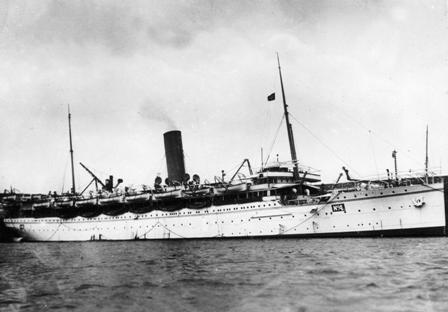 |
Tremendous seas arose, and the ship which had been routed fairly close inshore to avoid minefields, was driven off course. Shortly before four o'clock on the Friday morning the officers on duty felt the vessel rise under them, and heard a sound which the captain thought was caused by the explosion of a mine. Assuming that the "Rohilla" was vitally damaged, he tried to run her ashore to save life. Seven or eight minutes later she struck a mass of rocks head on, and remained firmly wedged, a few hundred yards from the dangerous headland of Saltwick Nab, a little more than a mile south of Whitby. Pounded by a furious sea, the "Rohilla" soon began to break up. Her signals were seen by the Coastguard, who at once called out the rescue services.
By 4.45 Langlands and his crew were ready, but for some time they could do nothing. In such a tremendous sea it would have been impossible to row the boat to Saltwick and attempt a rescue from the seaward side. The only possibility was to try to reach the wreck from the land. To do this, the lifeboat would have to be taken along the rough beach, or scaur almost to Saltwick Nab. Between Whitby and Saltwick the cliffs rise in an unbroken line to a height of some 200 feet. Near Saltwick there is a narrow and treacherous path leading to the scaur, but elsewhere the cliffs are almost perpendicular. Long, low spurs of rock point seawards. The beach is littered with fallen boulders. At high tide the foreshore is completely covered. The oncoming waves burst in huge spouts of spray as they sweep over the hidden rocks and hurl themselves against the foot of the cliffs, only to swirl back in a seething, vicious undertow. At low tide, it is possible to walk along the beach, picking one's way amongst the slippery rocks. No lifeboat had ever been taken on to the Scaur, but Langlands decided to make the attempt.
The outer harbour at Whitby, is protected by two massive stone piers about 30 feet high. The shoreward end of the East Pier is some distance from the cliff, the intervening space serving as a wave trap. This consists of a concrete breakwater, the full width of the pier and eight feet high. At full tide it prevents the waves from pouring unchecked into the harbour; at low tide it is an obstacle to those who wish to walk along the Scaur to Saltwick.
Langlands decided to wait until dawn, when the tide would be at its
lowest. The "John Fielden" was brought from her moorings near
the bridge, placed on the carriage and then with long ropes hauled to
the breakwater. The problem was to raise a boat which with her carriage
weighed over three tons, to the top of an eight foot breakwater, and
then lower her safely to the rough beach on the other side. Many people
thought it was impossible, but eventually it was done. Whatever materials
were available were used to break the force of the fall on to the Scaur,
but despite all precautions the boat was damaged in two places. The
"John Fielden" was then hauled steadily towards Saltwick.
Meanwhile, attempts had been made to throw a line across the wreck by
means of rockets. Scores of them were fired, but the apparatus was being
used at extreme range and the gale prevented most of them from reaching
the target. Some fell on the ship, but were inaccessible to the men
who were clinging to the battered superstructure.
One sailor risked his life to secure a line which had fallen within reach, only to find that it had been broken by friction against the rocks. Heavy seas had been crashing over the "Rohilla" for three hours, and had smashed or carried away all but one of the boats. About 7.30 a.m. this was manned and an attempt was made to bring a line ashore. A strong current carried the boat far to the northward; it was flung about wildly by huge waves, one of which tossed it completely round; one by one the oars broke under the strain, but eventually the boat came close in, steadily paying out the line. When, eventually the exhausted crew brought their line to land, it seemed that communication had been established with the wreck. To the intense chagrin of all on the beach, the line snapped before it could be used. The only hope lay with the lifeboat. Langlands brought the "John Fielden" along the beach, until, almost opposite the wreck, he found a suitable place to launch. His crew rowing against a tremendous sea and a rising tide had difficulty in reaching the "Rohilla"; but succeeded in taking off four nurses, a stewardess and twelve men, most of them medical staff.
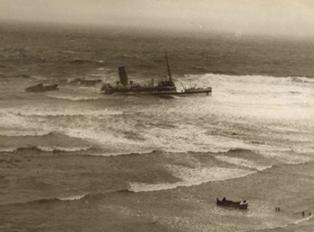 |
| The lifeboat preparing to launch to the aid of those on the stricken vessel. |
When the lifeboat turned towards the shore, it was carried northwards by the current, and was finally beached almost half a mile away from the place where it had been launched. It was replaced on its carriage and dragged back to Saltwick in readiness for a second attempt. The tide was coming in, making this trip even more difficult and dangerous than the first. This time, 18 men were taken off. Once more the lifeboat was beached well northward. The tide was rapidly approaching the foot of the cliffs compelling the launchers to leave the beach. The boat had been seriously damaged. Reluctantly Langlands decided that nothing more could be done, and the "John Fielden" was left to be battered against the rocks by the furious seas.
It was now about 10.30 a.m. and watchers on the cliffs could see the men on board the wreck, some half clothed, others in the pyjamas which they had been wearing when they were roused from sleep. Very shortly after she had struck, the "Rohilla" had broken in two: most of the survivors were on or near the bridge, but thirty or forty men were clinging to the stern. One by one they fell into the sea, until towards noon an unusually large wave swept over them. When the spray cleared, the stern and all on it had vanished.
The Local Secretary was seriously ill. Captain John Milburn who was directing operations, decided to try to take another lifeboat to Saltwick to replace the wrecked "John Fielden". The Upgang boat was brought out, and hauled to Whitby. A team of horses brought it through the town and to the edge of the East Cliff, opposite the wreck. Heavy ropes were attached to it, and long lines of men lowered it down the sheer face of the cliff. By 2.30 p.m. the boat was on the beach just south of Saltwick, but the tide was at the full and the seas were running far too high for a launch to be attempted. During the afternoon, Captain Milburn sought help from neighbouring ports.
It was impossible to get out of Hartlepool: the crew of the Teesmouth motor lifeboat were willing to make the attempt, but as they could not reach Whitby before dark it was decided that they should wait until the morning. At 5 a.m. they set out, but after some miles the boat was disabled and had to be towed back to Middlesbrough. The lifeboat Secretary at Scarborough reported that for the moment it was impossible for either the boat or a tug to leave the harbour, but they would try at the first opportunity. At 3,30 p.m. the Scarborough boat was launched and was towed to the scene of the wreck. She arrived about 6 p.m. on the Friday night. It was too dark for the lifeboat to venture close to the wreck, so she and her tug lay some distance to seaward throughout the night. On Saturday morning an attempt was made to reach the "Rohilla" but the lifeboatmen, who had been at sea in a furious gale since mid-afternoon on the previous day, were unable to bring their boat near enough to be of service, and so, wet, cold and hungry they were towed back to Scarborough.

At 7 a.m. the Upgang boat was launched from the beach to which it had been lowered on the previous afternoon: the crew struggled gallantly against terrific seas, but when they were about fifty yards from the wreck a huge wave swung the boat right round and carried it towards the shore. The exhausted men could make no more headway and were compelled to beach their boat.
On the previous day some of the "Rohilla's" crew had attempted
to swim ashore. After the failures of the lifeboats others followed
their example. Many were drowned, or broken against the rocks, but some
survived, and all day and throughout the night watchers patrolled the
beach, ready to plunge into the sea to haul swimmers to safety.
At three o'clock that morning the tug "Mayfly" had fought
her way out of Hartlepool. When she was off Whitby, Langlands took the
"Robert and Mary Ellis" out to the Rock Buoy, where she picked
up a line and was towed to Saltwick. Although the lifeboat was at one
time only 200 yards from the wreck, the crew were unable to bring her
alongside, and she had to be towed back to her station. The tug returned
to Hartlepool. A little later the "Robert and Mary Ellis"
put out again to try to pick up a man who had been seen on a make shift
raft near the end of the pier extension; but he was washed away before
he could be rescued.
It was late on the Saturday afternoon. The wreck was breaking up, and the gale was as furious as ever. More than thirty hours earlier the "John Fielden" which now lay on the beach damaged beyond repair, had made two successful attempts to bring off survivors.
Since then, three rowing lifeboats, from Scarborough, Upgang and Whitby, had done their utmost to reach the wreck, and had failed. Every device which experience and skill could suggest, had been tried; all that courage and determination could do, had been done: it was impossible for human strength to contend against such a storm. As a last resort, Captain Milburn asked for the help of the motor lifeboat stationed at Tynemouth, forty four miles away. The message was received at 4.15 p.m.; by 4.30 p.m. the boat had been launched, but it was not until 1 a.m. on the Sunday morning that the "Henry Vernon" entered the harbour. Lt. Basil Hall, R.N., who had been sent to Whitby by the Institution, had been preparing to make another attempt, using the Upgang boat, and had obtained several gallons of oil which, he hoped, could be poured into the sea close to the wreck, and so produce a quiet interval while the rescue was being carried out. When the "Henry Vernon" arrived the oil was transferred and at 6 a.m. he went out in her with the Tynemouth crew, taking the Whitby Second Coxswain, Richard Eglon, as pilot.
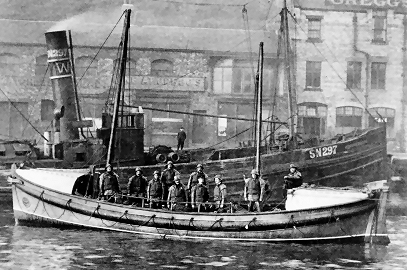 |
| The Tynemouth motor lifeboat Henry Vernon and her crew. |
A tremendous sea was still running, though it was not quite as heavy as it had been previously. Handled with great skill and daring, and helped by the use of the oil, the lifeboat was brought to the lee of the "Rohilla" and took off forty of the survivors. Before the rescue could be completed two enormous waves swept right over the wreck, almost overwhelming the lifeboat. She righted herself, the last ten men were hauled aboard, and then she started her return journey. While she was still broad-side to the seas, a great wave seemed to throw her on her beam ends, but recovering she ran in a wide semi-circle safely into Whitby harbour.
It had been a notable rescue: indeed the services rendered to the "Rohilla" over a period of 50 hours rank amongst the outstanding episodes in lifeboat history. Of the men who had been in the Tynemouth boat, two received the gold medal of the Institution, and three amongst them Richard Eglon of Whitby the silver. Langlands was awarded a gold medal, and the silver was given to George Peart, who had spent many hours on the beach near Saltwick, where "he behaved with conspicuous bravery in going into the sea and saving many of those who jumped overboard from the wreck".
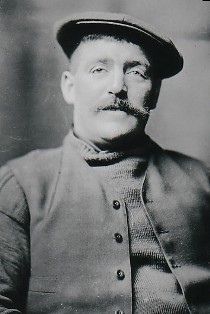 |
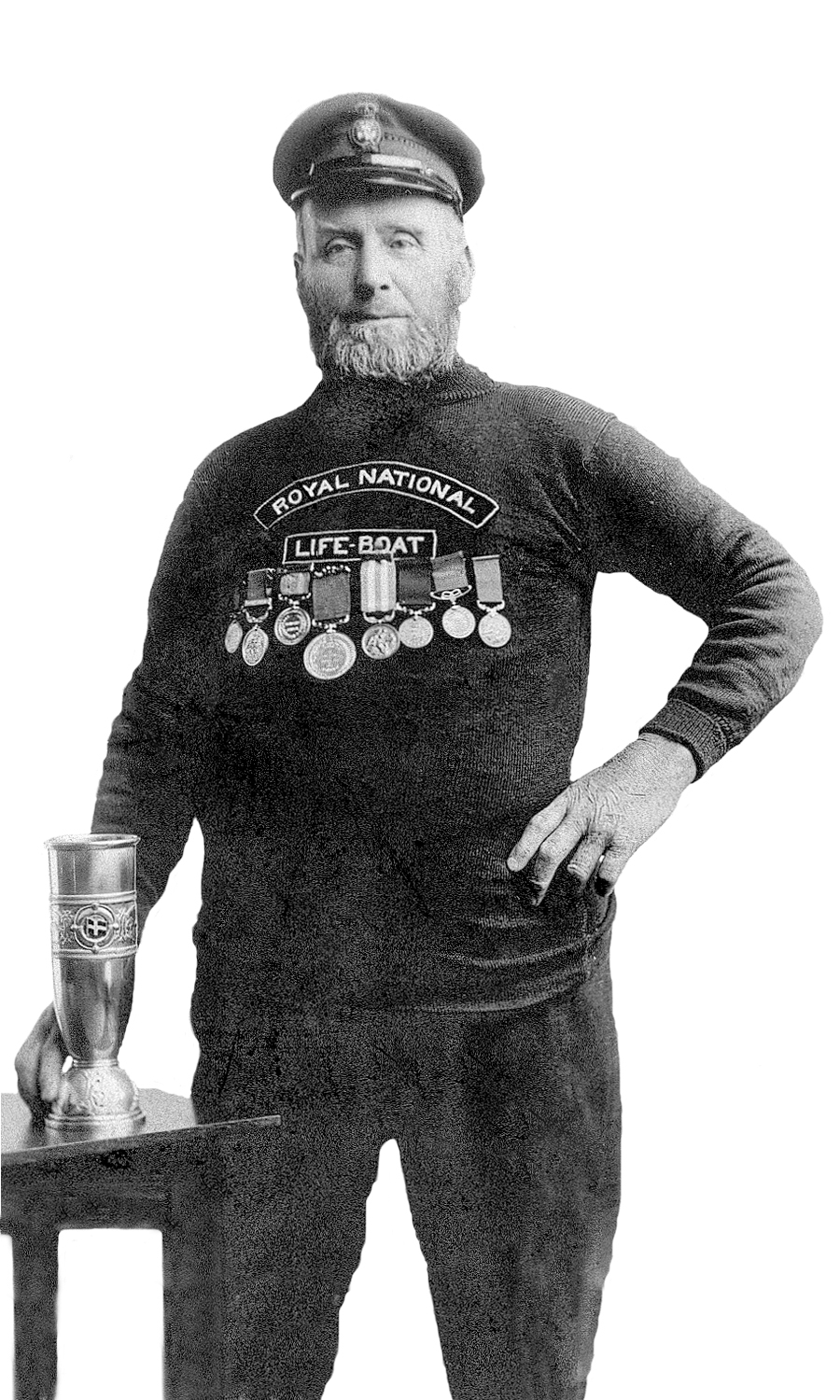 |
| George Peart, who waded tirelessly into the water to save those who made the safety of the shore. | The Tynemouth motor lifeboat Coxswain, Robert Smith |
Eighty four of the "Rohilla's" complement had been lost; sixty men had been saved by their own efforts, most of them by swimming ashore; the motor lifeboat had rescued fifty, and the rowing boats, thirty-five. The comparative failure of the rowing boats was recognised everywhere, though the heroism and endurance of their crews received unstinted praise. As a local Councillor remarked, "Everything went to prove that oar-propelled lifeboats are now of very little use.
They were all right in the days of wooden ships, when vessels carried small crews and when they came up on to the sand". The "Rohilla" being of deep draught, had struck well out, beyond the effective range of rowing boats in storm conditions. Lt. Hall, after the "Henry Vernon" had returned with the last survivors said, "No lifeboat propelled by oars could possibly have reached the wreck". The Chief Stoker of the "Rohilla" one of those who swam to safety, spoke of the courage of the lifeboatmen, and added "I consider it required steam power to reach us, and then only at grave risk. I cannot find words to express my gratitude for what has been done for us". The practical sympathy shown to them was never forgotten by the survivors. Former Sick-berth Attendant Leonard Long, probably the last survivor of the "Rohilla", wrote in May 1970, fifty-six years after the event: "I have been in several wrecks, but never have I had more help and kindness than from the people of Whitby. I remember them with gratitude".
The effectiveness of the "Henry Vernon" had made a great impression in the town. At the inquest on some of the victims of the disaster, the Foreman of the Jury asked Captain Milburn whether a motor-boat similar to that sent from Tynemouth could have got away from Whitby, had one been stationed there. Captain Milburn replied that had a motor-boat been available, it could have reached the wreck on the Friday morning. Langland's evidence showed that he too was convinced that the motor-boats were greatly superior to those propelled by oars. Three days after the rescue, Milburn made a public appeal for funds to purchase a motor lifeboat for Whitby. Money was subscribed rapidly; within a few weeks the Institution announced that the amount received, together with a bequest under the will of the late Miss Margaret Harker-Smith, was sufficient to meet the cost of a motor lifeboat which would be built specially for service at Whitby. By December 10th the Central Committee was discussing the details of the boat. In mid-January it was considering plans for a new boat-house, and for suitable launching gear. Unfortunately under war conditions it was not easy to obtain the necessary materials and labour.
There were protracted negotiations with the local authority, which objected to the site originally selected, and then sought to induce the Institution to contribute to the cost of a roadway near the new building. The boat-house was completed about the end of 1918. The new boat was placed on station at the end of May, 1919, nearly five years after the loss of the "Rohilla".
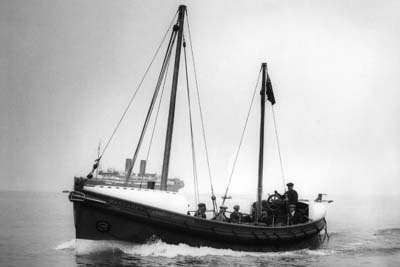 |
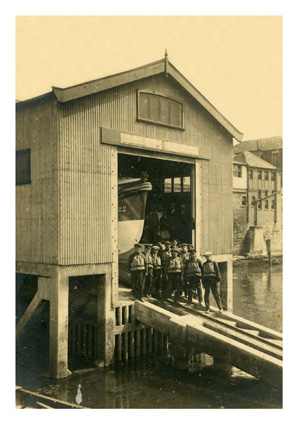 |
| Margaret Harker Smith, Whitby's first motor lifeboat | Erected in 1919 the boat house survived until 2007 when a new station was built |
Meanwhile the work of rescue was continued by the rowing boats. A reserve boat was sent to replace the "John Fielden" and did very useful service, frequently giving assistance to fishing craft near Whitby Rock and at the entrance to the harbour. In December 1915, the boats were called upon to rescue the crew of a steam vessel, which was ashore on Whitby beach, in much the same plight as hundreds of sailing vessels had been in earlier years. The S.S. Skane, timber laden from Scandinavia, had struck Whitby Rock. When she had been towed off, she was found to be so badly damaged that the salvors decided to beach her lest she should sink in deep water. Heavy weather drove her farther up the beach than had been intended; her crew were in serious danger as the tide rose, and the ship began to break up. The boats made three trips to the "Skane" and brought off 20 persons in safety. The vessel became a total wreck: her jagged ironwork remained rusting on the beach for many years, gradually sinking into the sand.
Because of war-time censorship, details of rescues were rarely published, but the Institution's records tell of one incident which must have kept the need for a motor lifeboat fresh in the minds of the local Committee. H.M. Minesweeper No. 849 was in trouble South of the port. The Whitby No. 1 lifeboat went out but because of very heavy weather, could do nothing and was compelled to return. The Runswick boat was launched but was forced to come into Whitby. Once more the rowing boats had attempted to do more than could be expected of them. Once more the motor-boat at Tynemouth was called upon to assist. She set out, but was recalled when she was off Sunder-land. The Minesweeper had been washed right up to the East Cliff and her crew had been rescued by means of rockets from the shore.
A month after the Armistice was signed, the District Inspector of Boats reported on the state of Whitby harbour. There had been no dredging during the war: the dredger was under repair and the Harbour Authority could do nothing until the repairs were completed. The harbour had silted up throughout its length and the Inspector was doubtful whether the new boat could be launched at all until some of the sand had been removed. Nevertheless he hoped that when the harbour had been properly dredged, the boat would be able to get out to sea at all states of the tide. Possibly because of this report, the "Margaret Marker-Smith" was not sent to her station until the end of May in 1919, though she had been ready in March,
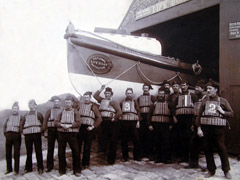
It was not necessary to maintain three rowing lifeboats in addition to the motor-boat. The relief boat, supplied at the end of 1914, was returned to London, and the Upgang Boat, the "William Riley", was transferred to Whitby as the No. 2 boat. The station at Upgang was closed. It had always been difficult to maintain, as the cliff against which the boathouse stood tended to move. Before long the house and launching slip became ruinous, and will no doubt eventually disappear.
An incident in July 1919 demonstrated the wisdom of retaining the two rowing boats at Whitby. A ketch, the "Fern" was seen making for the port after a very stormy night. The tide was low, and for a time she seemed likely to drift on to the Scaur. With difficulty she came in, but grounded about half way between the extension end and the end of the East Pier. She lay in broken water: efforts to move her by means of ropes failed, and the No. 1 boat took off the crew. Ultimately men on the pier extension hauled her off. A patrol boat was grounded near the end of the piers, but with great difficulty the "Fern" was brought to Boyes’ Staith where she was beached for inspection. Clearly the harbour was in an unsatisfactory state. In November it was reported that no dredging had been done since the previous June, and the Institution made urgent representations to the local Authority, as a costly motor lifeboat was out of action for practically six hours each tide, because of the silt. The situation was not much better in 1920 when the motor lifeboat struck a mud bank while being launched, and damaged her rudder beyond repair.
In September 1920 Langlands retired on pension. At the earnest request of the Local Committee, the Institution treated him as generously as its resources would allow, for few lifeboatmen could equal his record of service. He had joined the Whitby crew in 1871, and from 1877 - 1920 had been coxswain at Whitby and Upgang. In nearly fifty years of service he had helped to save over 200 lives. When he died in March 1922, his coffin was carried by members of his crew, and representatives of the Institution and of every lifeboat station from Bridlington to Hartlepool stood by his grave, close to those of the men who had died in the wreck of the "Rohilla".
About this time, the "Robert and Mary Ellis" ceased to be used for service. It was kept at Whitby and in 1934 was sold to Captain Milburn for £60. This was the end of the old "Whitby No. 1" station, though the motor-boat was soon called the Number 1. The No. 2 station remained active for many years, with a succession of boats, all of which had seen service at other stations. Naturally most of the work at Whitby was done by the "Margaret Harker-Smith" but sometimes the rowing boats assisted her. More usually the second boat stood by while fishing craft came in, or sometimes rescued the crews of small vessels in difficulties on the bar or at the entrance to the harbour. The service boards show that at this period the fishing fleet was being fitted with engines: about 1920 the record simply says "Fishing boat escorted"; ten years later the entry more commonly says, that "help was given to a motor fishing boat".
In 1931, the No. 2 boat was employed in a service for which the No. 1 boat would not have been suitable. After very heavy rain the river rose in flood. At Ruswarp the railway and road bridges were impassable; the current, estimated as running at 8 knots was carrying large trees down stream, and families were cut off in the upper rooms of their houses. The previous year, in similar circumstances the lifeboatmen had used a coble to rescue people from flooded buildings. This time they took the “Jacob and Rachael Valentine" up Khyber Pass, along Crescent Avenue and by Stakesby Vale.
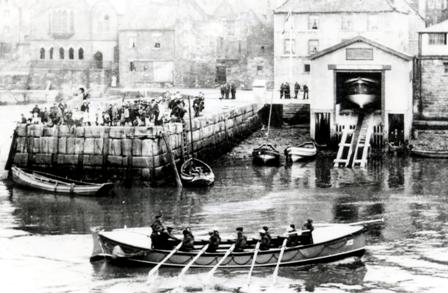
In spite of the current the boat crossed the river to save a family by way of the bedroom window. The men had great difficulty in moving an invalid lady of 90 into the boat. They then re - crossed the river, and saved a second family who were also in danger. The boat was slightly damaged, but it had performed a most unusual service.
In January, 1936, the same lifeboat was escorted by motor fishing vessels to the scene of a wreck. In a thick fog, the Icelandic trawler "Andri", with a crew of 17 and 8 seamen passengers, struck on Kelder Steel at Kettleness. The Runswick lifeboat went out, but could not approach the wreck. The Whitby No. 1 boat tried to launch but could not as there was not enough water. The rowing boat was manned and in a calm sea reached Kettleness soon after the motor fishing vessels which had set out with her. These seem to have made no attempt to reach the "Andri" but the " Jacob and Rachael Valentine" came alongside and took off eleven men. She was then towed back to Whitby by the Motor Fishing boat "Endeavour" but the tide was very low, causing the lifeboat to ground on the bar. The Icelanders jumped out and waded waist deep to the shore. The lifeboat returned for the rest of the crew, but by the time she reached the wreck, the "Andri" had managed to get a rocket ashore. The Kettleness Volunteer Life Saving Brigade sent a hawser across, a bosun's chair was rigged, and the 14 men left on the trawler were hauled ashore two at a time.
After that, in thick fog and pitch darkness, rescued and rescuers had to climb up the 200 foot cliffs on a rope. From the point of view of the lifeboatmen the incident demonstrated once more the difficulty of getting in and out of Whitby harbour at certain states of the tide.
In 1948, Mr. J. W. Foster, who had been local Secretary at Whitby for 44 years, retired and was appointed an honorary life Governor of the Institution. When he first took office, the rowing lifeboat was supreme: when he retired its day was almost over. In 1947 the last of the rowing lifeboats of Whitby was sent to the port after years of service at other stations. The "Robert and Ellen Robson" saved sixteen lives in the next ten years, but then the Institution decided that there was no justification for maintaining a rowing lifeboat at Whitby, and in 1957 the No. 2 station was closed. The lifeboat house, built to accommodate two boats, remained, and in 1958 was converted into a lifeboat Museum, with the "Robert and Ellen Robson" as its chief and most attractive exhibit. In the same year the last rowing boat in the Institution's fleet was withdrawn from service, but was not preserved. The result is that North Yorkshire has a unique distinction: it has at Redcar the oldest lifeboat in the world, and at Whitby the last rowing lifeboat to have been employed on service.
To return to the previous page use the link below.

Please note, in the book "The Rowing Life – Boats Of Whitby" the text did not contain the photographs which I have added to complement the original text
© A.F. Humble, M.A. 1974